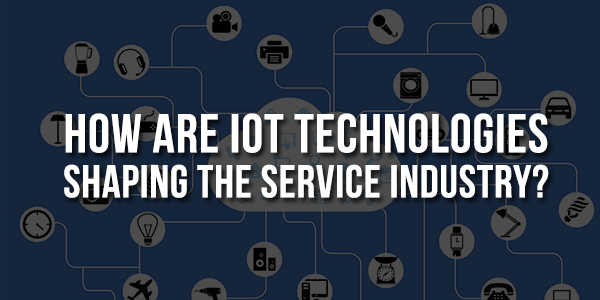
The Internet of Things (IOT) has been around for many years now, and it has established itself as a force that has transformed industries like manufacturing, logistics, and smart homes. Large budgets and advanced technology resources facilitated the early adoption of IoT among big players.
However, as IoT is maturing, the technologies necessary to put together an end-to-end IOT solution have become inexpensive and readily available. With that, IOT has started to penetrate service industries at large for its potential to create real value for businesses that distribute products or deliver on-site services.
Now that different service industries are leveraging IoT let’s see how IoT is helping them transform.
Table of Contents
The Combined Power Of IoT And Related Technologies
Different technologies come into play for building a robust IOT solution. When put together, IoT sensors and actuators, cloud computing, edge computing, ubiquitous connectivity, GPS, Artificial intelligence and Machine learning empower the service industry by enabling real-time visibility and promoting rapid decisions using huan+machine intelligence.
Which Areas Of The Service Industry Are Being Transformed With IoT?
IOT technologies help improve the field service operations of businesses, such as servicing at customer locations, inventory management and delivery cycle of goods and services. The service industry that operates through field services requires overcoming the constraints of remote work culture. An ecosystem of distributed field workforce working at different locations and shifts can very easily slow down the operations because of poor real-time visibility, communication gaps, inferior provisions for field data capturing and legacy workflow systems. IOT help overcome these limitations by positively affecting the three key areas of service businesses:
- Assets – Fixed and movable
- People- Field workforce and back-office employees
- Services- Services that are delivered on client sites
How Is IoT Helping Businesses Better Manage Their Assets, People And Services?
As IOT is maturing, IoT solutions are becoming simple and easy to implement, enabling the service industries to enhance the productivity of their workforce, improve operational efficiency and increase revenue. Specifically, these solutions are enabling the business managers in two ways:
- Have better visibility of the field workforce, assets and service deliveries
- Have the power to make data-based, more informed decisions further to enhance the orientation of assets, people and services.
Listed below are some of the scenarios showcasing how IoT solutions enable a service manager to better manage his business:
The manager always has real-time visibility of:
- What are my assets?
- Where are my assets?
- What is the status of my assets?
It helps him in making rapid and informed decisions like:
- Do I have the right assets?
- Are the assets being utilized efficiently?

IoT solutions help the manager better connect with his people, especially the field workforce deployed in distributed locations. The managers have real-time knowledge of:
- Where are my people?
- How much time are my people spending en route, at customer locations and in warehouses?
- How productively are my people behaving?
- Are my people safe and working in compliance?
Rapid and Informed decisions
- Are my people subjected to productivity leaks?
- Are the customers happy?
- Is the service-delivery cycle working smoothly?
Regarding the services, IoT solutions help the manager to understand.
- What is my team’s turnaround time?
- How strong is my team’s first visit effectiveness?
- How many service requests am I getting?
- What is the mean average success rate?
- How many service requests are getting cancelled?
It helps with rapid and informed decisions related to:
- Is the inventory being managed optimally?
- Am I selling my services to the right customers
- Am I selling at the right locations?
In conclusion, IoT solutions are helping service businesses to have a better insight into their operational challenges and also provide them with the solutions to overcome those challenges.
IoT has primarily risen to prominence for addressing service challenges with solutions like predictive maintenance, asset tracking, and advanced process automation. All these solutions work together to deliver results at different levels in a service cycle, but the major impact is observed when it helps improve precision in service tracking. It leads to various other positive outputs like effective workforce management, improved operational efficiency and reduction in productivity leaks.
How Do IoT Solutions Help With Service Tracking?
IoT facilitates service tracking by providing real-time visibility into the progression of a task, whether it is an application repair or a plumbing service. The IoT solution provides automated visibility. Here’s a quick picture of how IoT facilities service tracking:
- IoT devices that collect data at the point of work are called edge devices. Multiple IoT sensors embedded in edge devices observe the task watching for progress indicators.
- Edge devices collect the on-filed data, and then through Internet connectivity, they share the data.
- Next, the observational field data is fed into a centralized platform on the cloud.
- Then using front-end software applications and their human touchpoints, users can access the field data remotely from any location.
IoT-enabled service tracking and process automation lead to a range of benefits. Early adopters implement IoT solutions to reduce wait times by tracking the services with digital precision and automating the scheduling operations; increase operational efficiency to save customers time and also the workers’ and employees’ time. Efficient scheduling empowers the field workforce to see more clients and boost efficiency and profitability. IoT captured process data also exposes bottlenecks for workflow optimization for a sharper competitive edge.
Overall, these benefits help create a better overall customer experience, the key to growth indicator in service industries. Efficient operations, service progress updates, line-free service, quick turnaround time, and cost savings encourage customers to keep coming back.
Final Thoughts:
An end-to-end IoT solution built by putting together the right hardware, software components and cloud computing can produce transformative results for a service industry. There is no way to re-invent the wheel but there are innumerable ways to innovate it for advanced use cases; all it needs is a disruption. IoT is that disruption for the service industry that will innovate the field servicing ways to benefit the industry and its consumers.

 About the Author:
About the Author:
















Be the first to write a comment.